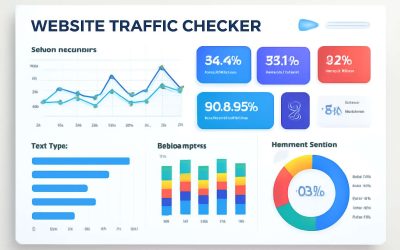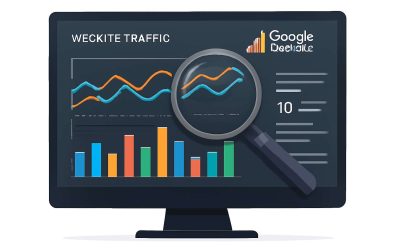Understanding Website Traffic Metrics
Defining Website Traffic – What constitutes website traffic and its significance
Understanding how website traffic is measured is akin to deciphering the pulse of a digital entity. It’s more than just numbers; it’s a reflection of human curiosity, intent, and engagement. When we measure website traffic, we are peering into the subconscious of your online presence, revealing what draws visitors and what repels them. This process isn’t merely about counting visitors but unraveling the story behind each click and scroll.
At its core, website traffic encompasses the volume of visitors who land on your pages, but it also involves the quality of that traffic—where they come from, how long they stay, and which paths they traverse within your site. This data holds the key to understanding the true impact of your SEO strategies. To grasp how website traffic is measured, consider these essential components:
- Source of traffic — organic search, direct visits, referrals, or paid advertisements.
- User behavior — page views, session duration, bounce rate.
- Conversion metrics — actions visitors take that align with your goals.
This intricate web of metrics forms the foundation for deep insights, revealing not just the “what” but the “why” behind visitor patterns—an essential step in mastering SEO’s silent language.
Key Metrics to Track – Visits, page views, unique visitors, and session duration
Understanding how website traffic is measured is akin to decoding the secret language of your digital domain. It’s not just about tallying the number of visitors but about unraveling the deeper story behind each click. Key metrics such as visits, page views, unique visitors, and session duration provide a nuanced portrait of your online performance. Think of visits as the overall foot traffic, while page views reveal how compelling each page truly is.
To really get to the heart of your website’s health, you need to examine how long visitors stay—because a quick bounce might suggest your content isn’t quite hitting the mark. This is where session duration comes into play, offering insight into visitor engagement. When combined, these metrics form a powerful lens into how website traffic is measured, offering clarity on what strategies are working and which need a little more SEO magic.
- Visits—how many times your site is accessed.
- Page views—total pages loaded during these visits.
- Unique visitors—distinguishing new eyes from returning ones.
- Session duration—the length of time visitors spend immersed in your content.
Difference Between Quantitative and Qualitative Data – Measuring numbers vs. assessing user engagement
Understanding how website traffic is measured requires more than just looking at raw numbers. It’s about delving into both quantitative and qualitative data—each offering a different lens into your digital footprint. Quantitative metrics, like visits and page views, give you the hard stats, revealing the size and scope of your audience. But these figures alone can be deceiving.
Qualitative data steps into the realm of user engagement—how visitors interact with your content, their behaviors, and their overall experience. For example, session duration can highlight whether your content captivates or merely catches fleeting attention. When combined, these insights create a compelling narrative about your website’s true health—an essential part of understanding how website traffic is measured in the context of SEO.
Tools and Technologies for Measuring Website Traffic
Google Analytics Overview – Features and benefits of using Google Analytics
Understanding how website traffic is measured can reveal hidden pathways to digital success. Tools like Google Analytics serve as a digital compass, guiding marketers and SEO specialists through the intricate landscape of user behavior. With its treasure trove of features, Google Analytics transforms raw data into actionable insights, making it an indispensable ally in optimizing online presence.
Its dynamic dashboard offers a panoramic view of visitor interactions, from where they originate to how long they linger on each page. The platform’s real-time analytics allow for immediate adjustments, ensuring that every piece of content resonates with the audience. By leveraging these insights, businesses in South Africa can finely tune their SEO strategies, knowing exactly how website traffic is measured and interpreted.

Among its arsenal of tools are detailed reports on user demographics, acquisition channels, and conversion rates. Together, these elements form a comprehensive picture, illuminating the pathways users take and the barriers they encounter. Such clarity is vital for crafting SEO campaigns that truly captivate and convert, making Google Analytics a cornerstone in the quest to decode how website traffic is measured effectively.
Other Popular Tools – Overview of tools like SEMrush, Matomo, and Adobe Analytics
In the bustling realm of SEO, knowing how website traffic is measured is akin to possessing a secret map in uncharted territory. While Google Analytics often takes center stage, the ecosystem of tools available today adds layers of sophistication that can turn mere numbers into strategic gold. For those eager to decode the digital footprints left behind by visitors, tools like SEMrush, Matomo, and Adobe Analytics offer compelling alternatives—and sometimes, delightful surprises.
SEMrush, for instance, provides a panoramic view of not just traffic but also competitive insights. Its ability to track keywords and backlink profiles complements your understanding of how website traffic is measured, ensuring no stone is left unturned. Meanwhile, Matomo champions privacy and customization, making it an appealing choice for South African businesses eager to keep control of their data. Adobe Analytics, on the other hand, excels at deep dives into user engagement, revealing the subtle nuances behind visitor behavior.
- Identify traffic sources with detailed acquisition reports.
- Analyze visitor behavior through heatmaps and session recordings.
- Track conversions and set custom KPIs to refine your SEO approach.
Each of these tools adds its unique flavor to the pursuit of understanding how website traffic is measured, enabling marketers to craft finely tuned strategies that resonate on every level of user interaction. After all, in this game of digital chess, knowing the terrain is half the victory—and these technologies are the seasoned guides that illuminate the path.
Tracking Code Implementation – How tracking code is embedded and configured
Embedding tracking code into a website is both an art and a science—an intricate dance that transforms raw visitor data into meaningful insights. It begins with placing a small snippet of code, often JavaScript, within the header or footer of your website’s pages. This snippet acts as a digital sentinel, silently capturing every visitor interaction and transmitting it back to analytics platforms. The precision of this process lies in correct placement and configuration, ensuring that data flows smoothly and accurately.
To customize data collection further, marketers can leverage advanced features like event tracking or custom dimensions. These options allow for a nuanced understanding of how website traffic is measured, revealing not just quantity but quality of engagement. As digital landscapes evolve, so too must the tools and techniques used to monitor visitors—making proper implementation of tracking code a cornerstone of effective SEO strategy.
Data Collection and Processing Methods
Cookies and Tracking Pixels – Role of cookies and pixels in tracking user activity
Understanding how website traffic is measured is akin to peering into the heartbeat of your online presence. Data collection methods like cookies and tracking pixels serve as silent witnesses, capturing every click and scroll with quiet precision. Cookies—those small text files stored on a user’s device—remember preferences and behaviors, providing invaluable insights into visitor patterns. Meanwhile, tracking pixels, tiny transparent images embedded in webpages or emails, silently relay user activity back to analytics platforms.
These tools work together to create a detailed map of user engagement, enabling businesses to refine their SEO strategies. For example, cookies can distinguish between new and returning visitors, while pixels track specific actions like form submissions or product views. Implementing these tracking mechanisms is straightforward; it often involves embedding a snippet of code into your website’s HTML, which then functions seamlessly in the background.
- Cookies store user preferences and session data.
- Tracking pixels monitor specific interactions and conversions.
By harnessing the power of cookies and pixels, website owners gain a clearer picture of how visitors navigate their sites, which is essential in understanding how website traffic is measured and optimized for better search engine performance.
Server Logs Analysis – Using server logs for traffic measurement
Behind every well-optimized website lies a wealth of data, often invisible to the naked eye. Server logs are one of the most fundamental tools to understand how website traffic is measured. These logs record every request made to your server, capturing vital information such as IP addresses, timestamps, requested URLs, and user agents. Analyzing this raw data can reveal patterns that other tools might miss.
By examining server logs, you can identify peak traffic times, popular pages, and even detect unusual activity that could indicate security issues. This method provides an unfiltered view of user interactions, making it indispensable for those serious about understanding their traffic metrics. Using server logs is especially helpful for uncovering details about visitor behavior that go beyond surface-level statistics.
- Extract raw log data from your server.
- Use specialized software or scripts to parse and analyze the logs.
- Identify trends and anomalies to refine your SEO approach.
While it may seem technical, incorporating server log analysis into your overall strategy offers a raw, unadulterated perspective on how website traffic is measured. It complements other analytics tools and deepens your understanding of visitor engagement, ensuring your SEO efforts are rooted in accurate, comprehensive data.
Real-Time Data Collection – Monitoring live user interactions
Understanding how website traffic is measured is crucial for any digital strategy, especially when real-time insights can make or break your SEO efforts. By monitoring live user interactions, you gain an immediate window into visitor behavior, allowing you to respond quickly to emerging trends or issues. This ongoing data collection captures every click, scroll, and hover, revealing patterns that static reports often miss.
Real-time data collection employs tools that track user engagement as it happens. For example, live dashboards display active users, popular pages, and geographic location—all in the moment. Some platforms even let you see how users navigate through your site, providing instant feedback on the effectiveness of your content and structure. This immediacy enables a more responsive approach to optimizing your website for search engines and improving user experience.
Analyzing Website Traffic Data for SEO
Understanding User Behavior – Assessing bounce rates, session duration, and engagement
Understanding how website traffic is measured goes beyond simple numbers; it reveals a story of user behavior and digital footprints. When analyzing traffic data, one crucial aspect is assessing bounce rates—the percentage of visitors who leave after viewing only one page. A high bounce rate may suggest that visitors aren’t finding what they need or that the landing page isn’t engaging enough. Equally important is session duration, which indicates how long users stay and interact with your content. Longer sessions often correlate with genuine interest and valuable engagement.
To truly grasp user behavior, consider tracking engagement metrics such as click-through rates and scroll depth. These insights help identify which parts of your website resonate most with visitors, guiding future SEO strategies. For example, an increase in time spent on a particular product page could signal that your content effectively addresses customer needs. By carefully examining these patterns, businesses in South Africa can refine their SEO efforts, ensuring their website’s traffic is not just increasing but also meaningful and targeted.

Traffic Source Analysis – Identifying organic, direct, referral, and social traffic
Understanding where your website visitors originate is like unlocking a hidden map of digital pathways—each source telling a unique story about your audience. When exploring how website traffic is measured, analyzing traffic sources becomes an essential step in uncovering the true reach of your SEO efforts. Organic traffic, driven by search engines, often indicates the strength of your SEO strategies, while direct traffic reveals brand recognition and loyalty. Referral traffic showcases your network’s influence, and social traffic highlights engagement through social platforms.

To visualize this, imagine a simple flowchart that categorizes visitors into these four distinct groups. Recognizing these segments allows businesses in South Africa to fine-tune their SEO tactics, ensuring each avenue is optimized for maximum impact. By delving into these different streams, you gain clarity on which channels are truly driving meaningful traffic—fueling smarter decisions and amplifying your online presence.
Keyword Performance Tracking – Linking traffic to specific SEO keywords
In the shadowed corridors of the digital realm, understanding how website traffic is measured becomes an act of unveiling concealed stories. Each visitor’s journey whispers secrets about your SEO prowess—clues hidden within the labyrinth of data. When analyzing traffic, linking the flow to specific keywords transforms raw numbers into a tapestry of intent and interest. It’s as if you’re deciphering a cryptic language spoken by your audience, revealing which phrases summon the most visitors from the depths of search engines.
Through careful examination, you discover patterns—certain keywords conjure waves of organic traffic, while others spark fleeting visits. This insight isn’t merely academic; it’s the key to refining your SEO tactics in South Africa’s fiercely competitive digital landscape. Recognizing which keywords drive meaningful engagement allows your website to resonate more profoundly, elevating your online presence amidst the shadows of the web.
Interpreting and Utilizing Traffic Data
Identifying Trends and Patterns – Spotting seasonal or campaign-driven changes
Understanding the ebb and flow of website traffic is akin to decoding a complex symphony—every note and pause tells a story. When analyzing how website traffic is measured, it’s essential to recognize the subtle shifts that signal deeper trends. Seasonal fluctuations, for instance, often reveal when audiences are most engaged or when specific campaigns hit their stride. These patterns aren’t random; they’re the clues that reveal what truly resonates with visitors.
Spotting these trends requires a keen eye and a strategic approach. By examining fluctuations over days, weeks, or months, you can identify periods of heightened activity or quiet lulls. Such insights empower marketers to fine-tune their SEO strategies, ensuring content aligns with user behavior. Whether it’s a spike caused by a holiday sale or a dip during off-peak months, understanding these patterns is key to optimizing for long-term success.
Assessing Content Performance – Determining which pages attract the most traffic
Understanding how website traffic is measured goes beyond mere numbers; it’s about deciphering the silent language of your visitors. When assessing content performance, it’s crucial to identify which pages resonate most—these are your digital hotspots. By examining metrics such as page views, bounce rates, and session durations, you gain insight into what truly captivates your audience. Sometimes, a spike in traffic on a particular page signals a successful campaign or a trending topic, while a lull might suggest content needs reimagining.
To truly harness this data, consider breaking down the top-performing pages into categories: the ones that convert, inform, or entertain.
- Identify the pages with the highest engagement.
- Assess how users navigate through your site.
- Determine which keywords drive traffic to these pages.
This layered understanding allows marketers to align their SEO efforts with genuine user interests, transforming raw data into strategic gold. When you grasp how website traffic is measured, you unlock the power to refine your content—making every visitor count in the grand symphony of digital presence.
Optimizing SEO Strategies – Using data insights to refine keywords, content, and user experience
In the shadowy realm of digital strategy, understanding how website traffic is measured becomes an art as much as a science. The true power lies not just in numbers, but in the stories they whisper—secrets about your audience’s desires and habits. When you delve into traffic data, you begin to see patterns that reveal which pages cast the brightest glow on your digital landscape. These insights are like lanterns in the darkness, guiding your next move.
By interpreting metrics such as bounce rates, session durations, and the pathways visitors take, you can craft a more alluring tapestry of content. Sometimes, a surge of visitors to a particular page hints at a viral moment, while a lull might beckon you to reimagine your narrative. When you comprehend how website traffic is measured, you unlock the ability to refine your SEO strategies—adjusting keywords, enhancing user experience, and aligning your content with what truly captivates your audience. Navigating this data is akin to deciphering a cryptic map that leads to greater engagement and visibility in the vast digital night.
Challenges and Best Practices in Measuring Website Traffic
Dealing with Data Noise and Spam – Filtering out irrelevant or malicious traffic
Measuring website traffic isn’t just about tallying numbers; it’s a battle against chaos. One of the toughest challenges in understanding how website traffic is measured is dealing with data noise and spam. Malicious bots and irrelevant visits can skew metrics, making it seem like your site is thriving when in reality, it’s just smoke and mirrors. Filtering out this unwanted traffic requires sophisticated tools and vigilant oversight, but even then, some spam slips through the cracks.
This is where best practices come into play. Implementing robust filtering techniques—such as excluding known bots and suspicious IP addresses—can dramatically improve data accuracy. Regularly auditing your traffic sources helps detect anomalies, while setting up filters within analytics platforms ensures that only genuine user interactions are recorded. When you manage to tame the chaos, your insights become sharper, revealing true user behavior and performance trends—key to mastering how website traffic is measured for SEO success.
Ensuring Data Privacy Compliance – Balancing analytics with privacy laws
Balancing the quest for insightful analytics with the imperatives of data privacy is one of the greatest challenges in understanding how website traffic is measured. As regulations like the POPIA in South Africa tighten, maintaining compliance while gleaning meaningful insights becomes a delicate dance. If you’re not cautious, you risk violating user trust or, worse, legal repercussions that could cripple your digital strategy.
Implementing privacy-focused measures is crucial. This involves anonymizing user data, respecting opt-out preferences, and ensuring transparent data collection practices. An effective approach is to employ privacy-centric analytics tools that prioritize user consent, allowing you to capture valuable metrics without overstepping legal boundaries. Remember, the goal isn’t just about collecting data but doing so ethically—after all, trust is the currency of online engagement.
- Regularly review your data collection protocols to stay aligned with evolving privacy laws.
- Maintain clear communication with users regarding how their data is used and protected.
- Limit data access within your team, ensuring only authorized personnel handle sensitive information.
In this landscape of strict compliance, the art of measuring how website traffic is measured hinges on transparency, respect, and meticulous oversight. When done right, you uncover authentic user behavior that fuels your SEO efforts—without compromising the trust that keeps visitors coming back.
Maintaining Data Accuracy – Avoiding common measurement pitfalls
Measuring how website traffic is measured is no small feat—especially when striving for accuracy amidst a sea of digital noise. One of the most common pitfalls is relying solely on raw numbers without context, which can lead to skewed insights. For instance, spam traffic or bot activity can inflate your metrics, making it seem like your content is resonating more than it truly is. To combat this, employing filtering techniques to identify and exclude such anomalies is essential.
Another challenge lies in tracking user behavior across multiple devices and sessions. Without proper configuration, data can fragment, obscuring the true picture of visitor engagement. Techniques like cross-device tracking and session stitching help paint a more authentic portrait of user journeys. Remember, the key to precise measurement is vigilance—regularly reviewing data collection methods and ensuring they align with evolving privacy standards keeps your insights trustworthy and meaningful.



0 Comments